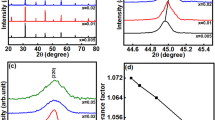Abstract
This study utilized a conventional solid-state reaction method to prepare ZnO–Bi2O3–Sb2O3–Co3O4–Mn3O4–Nb2O5 varistors sintered at low temperatures of 860 °C–880 °C. The effects of the different amounts of SiO2 and SiO2-B2O3 co-doping on the microstructure and varistor properties were investigated. The nonlinearity coefficient (α) increased from 51 for the sample without adding SiO2 to 66 for the sample with 1.0wt% SiO2, and the breakdown voltage increased from 834 to 1260 V/mm. However, with excess SiO2 addition, the α value gradually decreased from 66 for the sample with 1 wt% SiO2 to 52 for the sample with 2.0 wt% SiO2, while the breakdown voltage continued to increase. Co-doping SiO2–B2O3 improves liquid phase sintering due to the relatively low melting point of SiO2–B2O3–Bi2O3 additives. The α value increased from 66 for the sample without adding B2O3 to 83 for the sample with 2.0 wt% B2O3, while the breakdown voltage decreased from 1260 to 1120 V/mm. In comparison to higher temperature alternatives, the lower sintering temperatures (860 °C–880 °C) used in this study result in lower energy consumption during the manufacturing process. Because of their favorable cost-energy efficiency ratio, the SiO2–B2O3 co-doped ZnO–Bi2O3 varistors emerge as promising candidates for large-scale production.





Similar content being viewed by others
Data availability
All data generated or analyzed during this study are included in this published article (and its supplementary information files).
References
L.F. García, F. Azough, G. Parsons, A.A. Quadling, B. Wang, R. Freer, Optimising the performance of SiC-based varistors through composition and microstructure control. J. Europ. Ceram. Soc. 42, 600–607 (2022)
T.K. Gupta, Application of zinc oxide varistors. J. Am. Ceram. Soc. 73, 1817–1840 (1990)
H.I. Hsiang, C.C. Chen, C.C. Kao, Effect of ZnBi2O4 and Bi2O3 addition on the densification, microstructure, and varistor properties of ZnO varistors. Ceram. Inter. 49, 2244–2249 (2023)
S. Rodewald, J. Fleig, J. Maier, Microcontact impedance spectroscopy at single grain boundaries in Fe-Doped SrTiO3 polycrystals. J. Am. Ceram. Soc. 84, 521–530 (2001)
Y. Lu, Y. Li, R. Peng, H. Su, Z. Tao, M. Chen, D. Chen, Low-temperature sintering and electrical properties of BBSZ glass-doped ZnO-based multilayer varistors. Int. J. Appl. Ceram. Technol. 17, 722–727 (2020)
S. Wan, W. Lu, X. Wang, Low-temperature sintering and electrical properties of ZnO-Bi2O3-TiO2-Co2O3-MnCO3-based varistor with Bi2O3-B2O3 frit for multilayer chip varistor applications. J. Am. Ceram. Soc. 93, 3319–3323 (2010)
Y.M. Shen, H.I. Hsiang, Effects of the sodium ions addition on the varistor properties of ZnO-Co3O4-Pr6O11 ceramics. J. Mater. Sci. Mater. Electron. 32, 28935–28941 (2021)
H.I. Hsiang, H.R. Tsai, C. Pithan, Effects of Sr(Co, Nb, Ta)O3 addition on the defect structures and electrical properties of ZnO-based varistors. J. Mater. Chem. C. 10, 9644–9654 (2022)
H. Cerva, W. Russwurm, Microstructure and crystal structure of bismuth oxide phases in zinc oxide varistor ceramics. J. Am. Ceram. Soc. 71, 522–5304 (1988)
H. Bai, M. Li, Z. Xu, R. Chu, J. Hao, H. Li, C. Chen, G. Li, Influence of SiO2 on electrical properties of the highly nonlinear ZnO-Bi2O3-MnO2 varistors. J. Europ. Ceram. Soc. 37, 3965–3971 (2017)
S. Hong, L. Niu, Y. Chen, M. Wang, Effects of B2O3 content on the microstructure, electrical properties, and stability of ZnO-BaO-based varistors. J. Electron. Mater. 50, 3706–3713 (2021)
K. Mukae, K. Tsuda, I. Nagasawa, Capacitance-vs-voltage characteristics of ZnO varistors. J. Appl. Phys. 50, 4475–4476 (1979)
P. Peng, Y. Deng, J. Niu, L. Shi, Y. Mei, S. Du, J. Liu, D. Xu, Fabrication and electrical characteristics of flash-sintered SiO2-doped ZnO-Bi2O3-MnO2 varistors. J. Adv. Ceram. 9, 683–692 (2020)
Z. Xu, Y. Wei, S. Ma, X. Guo, G. Li, R. Chu, J. Qiu, Low breakdown electric field B2O3–doped ZnO–Bi2O3–TiO2–Co2O3–MnO2 varistor ceramics fabricated by low temperature sintering. J. Mater. Sci. Mater. Electron. 34, 342 (2023)
Z. Xu, S. Ma, R. Chu, J. Hao, L. Cheng, G. Li, Low-temperature sintering of high potential gradient B2O3-doped ZnO varistors. J. Mater. Sci. Mater. Electron. 26, 4997–5000 (2015)
W. Liu, L. Cheng, J. Ai, K. Su, W. Li, Enhancement of microstructure development and current-voltage characteristics of ZnO-Bi2O3 varistor ceramics sintered with sintering aids at the low-temperature. IOP Conf. Series: Mater. Sci. Eng. 678, 012146 (2019)
Acknowledgements
This work was supported by the National Science and Technology Council, Taiwan [112-2221-E-006 -063 -MY3]. The authors gratefully acknowledge using the Core Facility Center, National Cheng Kung University, Taiwan.
Funding
National Science and Technology Council, Taiwan [112-2221-E-006 -063 -MY3].
Author information
Authors and Affiliations
Contributions
Conceptualization, H-IH and Y-MS; methodology, M-CL; validation, H-IH, and M-CL; formal analysis, M-CL; investigation, M-CL; resources, H-IH; data curation, M-CL; writing—original draft preparation, H-IH; writing—review and editing, H-IH and Y-MS; visualization, H-IH; supervision, H-IH and Y-MS; project administration, H-IH; funding acquisition, H-IH and Y-MS. All authors have read and agreed to the published version of the manuscript.
Corresponding author
Ethics declarations
Conflict of interest
The authors declare no conflict of interest.
Additional information
Publisher's Note
Springer Nature remains neutral with regard to jurisdictional claims in published maps and institutional affiliations.
Supplementary Information
Below is the link to the electronic supplementary material.
Rights and permissions
Springer Nature or its licensor (e.g. a society or other partner) holds exclusive rights to this article under a publishing agreement with the author(s) or other rightsholder(s); author self-archiving of the accepted manuscript version of this article is solely governed by the terms of such publishing agreement and applicable law.
About this article
Cite this article
Shen, YM., Len, MC. & Hsiang, HI. Effects of SiO2 and B2O3 on electrical properties of low-temperature sintered ZnO–Bi2O3 varistors. J Mater Sci: Mater Electron 35, 92 (2024). https://doi.org/10.1007/s10854-023-11800-0
Received:
Accepted:
Published:
DOI: https://doi.org/10.1007/s10854-023-11800-0




